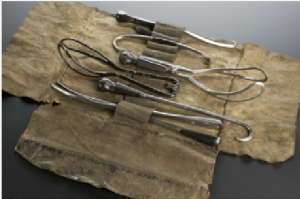by Helen King (Regular Contributor)
If you freeze at the sight of a medical instrument, you are not alone. Historically, physicians have tried various methods to reduce the fear induced in the patient by seeing what is coming their way.For women, possibly the most scary of all is the obstetrics forceps … if there was ever an instrument to strike terror into the heart, surely it must be this. In the eighteenth century, the man-midwife William Smellie, aware
 of the effect on a woman in labor of hearing that metallic clanking sound, experimented with leather coverings for the blades, to muffle the noise. Not a good idea, in terms of cross-infection, and his rival Thomas Burton noted that the leather would ‘corrupt and stink’ – but of course germ theory was not accepted for another hundred years or so.
of the effect on a woman in labor of hearing that metallic clanking sound, experimented with leather coverings for the blades, to muffle the noise. Not a good idea, in terms of cross-infection, and his rival Thomas Burton noted that the leather would ‘corrupt and stink’ – but of course germ theory was not accepted for another hundred years or so.
Smellie argued for the antiquity of the forceps, tracing their history back to the Arabs, and proposing that in the medieval Arab world they had been used to extract live babies. In the nineteenth century, Sir James Young Simpson too discussed the history of the forceps in his lectures, also emphasizing how far back their use went, but claiming that the earliest ones were ‘instruments of a fatal nature’. Both men talked about the range of designs that had been used. And in their own practice, both tried out ones with straight blades, curved blades, long handles and short handles. Having your own preferred type of forceps was part of the theatrical side of medicine.
Simpson warned his pupils that they must always tell the patient’s family if they were about to use forceps, otherwise they’d be blamed if something went wrong. But what about telling the patient herself? Well, he suggested, it all depends on her temperament. Most women, he argued, are fine about it, and some even ask for forceps if they have needed them before. He went on:
“You will then in most cases tell the patient, but explain to her that it is not a cutting instrument, and if she wish to see it I should have no objection in allowing it, and have done so frequently: in France they have now an advantage over us in this respect, that they have most of their instruments gilded, which renders their appearance somewhat less formidable and more agreeable. I used to know an old practitioner who prided himself upon having a good leg of his own and was in the habit of showing it off by grasping his thigh with the forceps when exhibiting their mode of action to the patient”.
While this image of the demonstration of the forceps on the physician’s thigh is one that I find difficult to erase from my mind, that comment on the appealingly gilded French instruments to me recalls a much earlier practitioner: the second-century Galen, who wrote in Greek and worked at Rome. Galen was very attached to his medical instruments, and mentions the wax molds for instruments he had designed himself, which were lost in a fire that destroyed the warehouse where he stored them in Rome. In his treatise On Prognosis he condemned his peers who used silver for their medical instruments; it’s just too flashy. This seems to be a deliberate reference to an even earlier comment on the materials for medical instruments; in the Hippocratic treatise The Doctor, bronze is recommended as the best material for surgical instruments, but in other areas of medicine the anonymous writer said ‘it seems to me tasteless ornamentation to have all one’s equipment in bronze’.
Bronze was seen as ‘going too far’ for most purposes; then silver came into fashion; and finally, gold. In the interests of impressing, or reassuring, the patient, medical instruments could be a form of bling.
References:
Notes of a Series of Lectures on Natural and Morbid Parturition delivered by Professor Simpson (Royal College of Physicians, Edinburgh: Ed. 1843-4)
Galen, On Prognosis: edition and translation by V. Nutton: Galen On Prognosis, Corpus Medicorum Graecorum, V.8.1, 1979
Helen King, Midwifery, Obstetrics and the Rise of Gynecology, Ashgate, 2007
